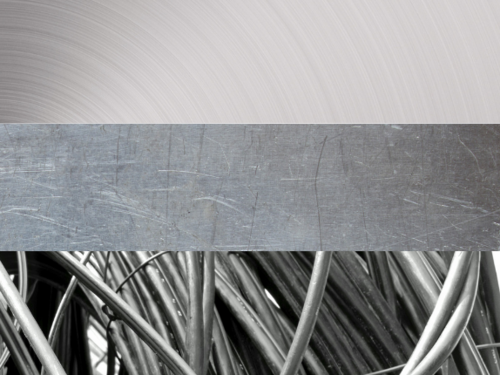In PUK Portacables there are 4 main materials:
- Iron
- Steel
- Wire
IRON
A base material, since it is the raw material necessary for the production of other materials. Belonging to the group of transition metals in the periodic table, iron (Fe) is not usually found in its pure state, but mixed with other minerals. In the absence of hard evidence, there are indications of its use as early as Ancient Egypt, although its peak came around 1,000 BC, with what is known as the Iron Age. At that time, its use became popular as an alternative to bronze.
As it is found in mineral compositions, especially in oxides like hematite and magnetite, together with titanomagnetite and pisolitic iron rock, limonite and siderite, its production requires first reducing the original oxide and then refining it and disintegrating its impurities. Usually, the process is based on calcination of the minerals, their reduction, which gives way to an initial forging before working in greater depth on the purity, shapes and final appearance of the iron. It is a hard, dense and, at the same time, malleable material, which contains magnetic properties. These conditions make iron an essential ingredient when making alloys to obtain different materials.
A remarkable fact is that it is at the same time an essential element at a biological level. It can be found in hemoglobin (pulmonary function), or in myoglobin (muscular function) and its shortage or excess can cause organic failures, especially related to the circulatory system.
STEEL
An essential material in industry and construction because of its hardness, strength and reliability. There is no steel with a high purity of 100%, because it is an alloy obtained from the combination of iron and carbon (C), zinc (Zn), silicon (Si) or even aluminum (Al). Discovered by pure serendipity around the second half of the Iron Age when the process of forging iron weapons changed, it owes its name to the Latin aciarius (white weapon).
It is manufactured in steel mills, large spaces set up to prepare and break down materials in order to create steel, although they are also known as "big furnaces" in the context of the iron and steel industry. Generally, the process involves at least three steps: electric furnace to melt the raw materials, ladle furnace to work the liquid steel and continuous casting, where the material solidifies and a semi-product is obtained.
Steel is one of the most frequently used materials in PUK Portacables' work: because of its qualities, it is always an excellent choice, but even more so is hot-dip galvanized steel. This derivative is based on a purified steel, covered by one or several layers of zinc in an electrochemical process, obtaining a high resistance against corrosion. An ideal alternative when it comes to works in adverse weather conditions, such as humid climates.
WIRE
The wire ends the presentation of the metallic materials most commonly used in PUK Portacables. The curiosity of this element lies precisely in its composition: iron, copper, brass, silver or aluminum. Historically, it was obtained by beating metal sheets according to the thickness that had to be obtained. The resulting sheet was then hammered to round its edges until a thin wire cable was obtained. Well into the 19th century, in England they modernized the method and began to produce wire using machines, until they reached the agile and automated process we know today.
As a metallic alloy, what sets wire apart from other materials is its windability and versatility, which is largely due to the mixture of compounds and its infinitely variable possibilities. For example, while enameled copper wire is most often used in the manufacture of electrical cables because of its insulating quality, steel and stainless steel wires, usually with a galvanized surface to combat corrosion, are commonly used in industry.
Easily handled and transportable due to the considerable weight reduction, depending on its coverage it can be adapted to different uses. Thus, higher resistance to high temperatures, more flexibility and adaptation to curvatures or even greater tolerance to exafluorocarbon (used as a gas in compressors) can be sought.
At PUK Portacables we customize the sizes and thicknesses of our products for each customer, while advising on the choice of the ideal material, always focusing on the purpose of the project and its location. Only the absolute knowledge of each product, together with 30 years of experience, give us the authority and security to make the right choice.
